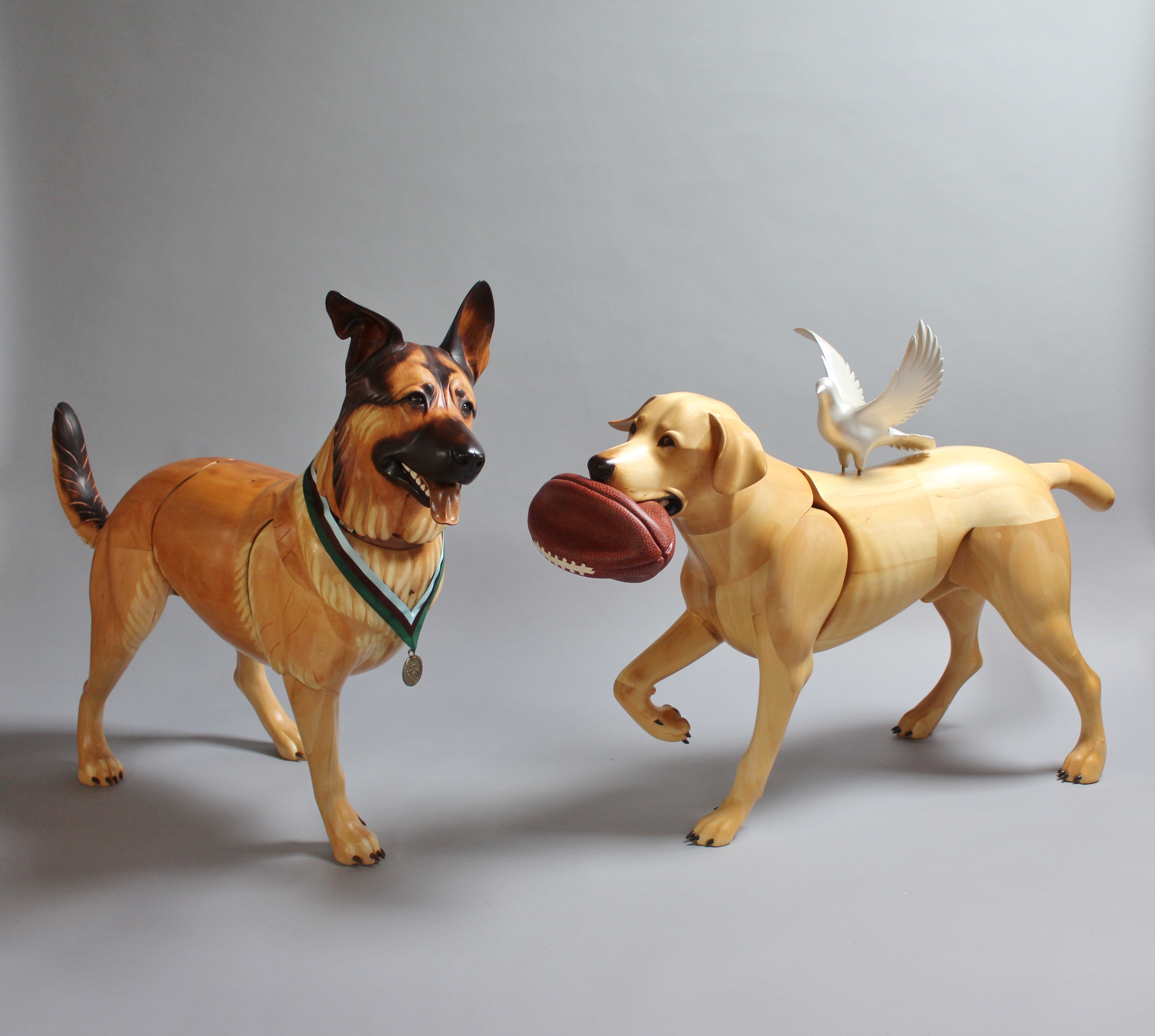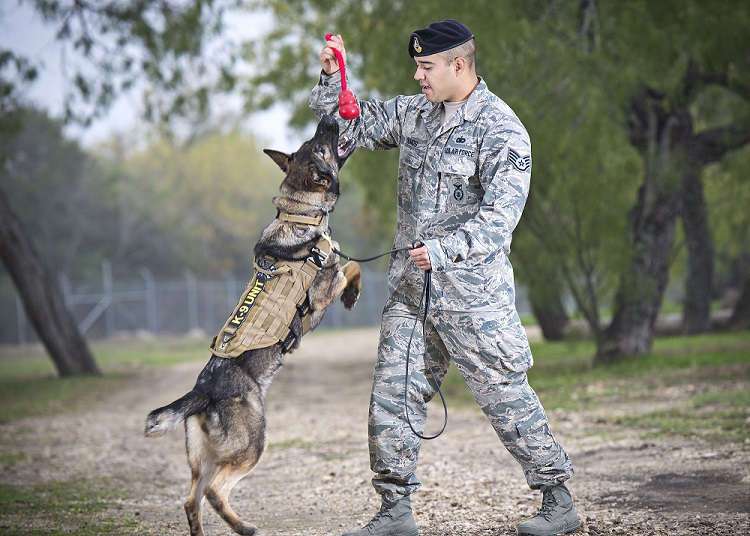Canine Warriors
Courage and Sacrifice, Always Beside You
A temporary exhibit featuring Wounded Warrior Dogs wooden sculptures by artist James Mellick will be on display in the Kettering Hall from Nov. 8, 2019 through Jan. 31, 2020.
Note from the artist:
Wounded Warrior Dogs Project
I am moved by the physical and emotional sacrifices made by the men and women of the United States military. Contemporary medical technology and triage on the battlefield have resulted in more veterans surviving from injuries that would have proved even more crippling or fatal if suffered in earlier wars.
In my limited and small way, I want to pay tribute to the members of the military, who served with great sacrifice, by creating this sculptural allegory of wounded warrior dogs who were their handlers’ best friends and companions in battle.
The Wounded Warrior Dogs Project is a traveling exhibition of wooden dog sculptures, intended to be symbolic of the sacrifices made and the wounds suffered by their human companions in battle. This installation of wounded and rehabilitated dogs is intended to open dialogue and encourage psychological healing of veterans and families, call attention to the ongoing needs of physically and psychologically wounded veterans through our bond with faithful canine companions, and bring attention to the service and heroism of military working dogs.
About the artist:
James Mellick
A native of Ohio, Jim Mellick has been creating art and teaching art since the 1970s. He received his Master of Fine Arts from Southern Illinois University in 1973. His preferred medium is wood, from which he sculpts movement, life, and emotion. Retiring from full-time teaching in 2014, he began the creation of the “Wounded Warrior Dogs Project” and started touring the exhibition in 2015.
The National Museum of the US Air Force is grateful for the support of the Air Force Museum Foundation, which made this temporary exhibit of “Canine Warriors” possible.

Over the Rainbow Bridge
Story of Lucca and Cooper:
Lucca K458 is laminated and carved basswood that has been bleached, stained, and burned for coloring. Tongue is carved cherry and teeth are maple. The medallion replica of the Dickin Medal is 3D-printed.
Cooper K154 is laminated and carved basswood. Dove and football are carved and painted basswood.
Lucca, a German Shepherd/Belgian Malinois mix, served with the US Marine Corps as a specialized search dog for over six years and more than 400 missions. In 2012, while on patrol in Afghanistan with her handler, Corporal Juan Rodriguez, she was hit by an Improvised Explosive Device (IED) blast. Cpl Rodriguez performed life saving techniques on Lucca before she received treatment by surgeons who amputated her leg and treated burns to her chest and torso. In 2016, she received the Dickin Medal for “conspicuous gallantry” by the People’s Dispensary for Sick Animals, Britain’s highest award for valor by a military animal. In retirement, Lucca became an ambassador for the military working dog community and brought awareness regarding the service and sacrifice of MWDs and their handlers.
Lucca is joined by her friend Cooper, a yellow Labrador she met during her first deployment in 2007. Between patrols, Lucca and Cooper often napped together or played with a deflated football. However, on July 6, 2007, while on patrol, an insurgent remotely detonated an IED hidden in a haystack, killing both Cooper and her handler, US Army Corporal Kory Weins of the 94th Mine Dog Detachment, 5th Engineer Battalion, 1st Engineer Brigade. They were the first dog handler team killed during the Global War on Terror; their ashes were buried together.
The dove on Cooper’s back signifies the angel wings he earned for devotion to duty. The football represents Cooper’s earthly connection to Lucca. The statues celebrate the dogs’ playfulness and camaraderie, which brought joy to warfighters who faced peril every day.

Military Working Dogs:
The military working dog (MWD) fills a special role in the protection of military troops. Dogs have been present in the US military since the Revolutionary War, however, it was not until World War II that the military developed a large, standardized dog handler program. At that time, the US Army created training techniques and established schools for handlers.
The military has explored different options for acquiring strong, intelligent, and resilient dogs. Initially MWDs were obtained through personal donations from patriotic dog owners, but the most efficient systems have used brokers and the US Air Force’s Belgian Malinois breeding program. In 1998, the Air Force opened the Department of Defense (DoD) Military Working Dog Breeding Program at Joint Base San Antonio-Lackland, Texas. The 341st Training Squadron’s “puppy program” fulfills a third of the DoD’s working dog requirements.
Dogs are the perfect fit for security forces due to their acute senses, affection for people, watchfulness, and speed. These faithful companions are exposed to the same harsh environments and battlefield dangers as their handlers, increasing their risk of disease, injury, and death. Their diligence is rewarded with praise from their handlers, the joy of a chew toy, and the security of our military. At the end of their careers, most MWDs are offered to civilian law enforcement agencies or are available for adoption, with handlers having first priority. More than 90 percent of former MWDs are adopted by their handlers.
Click here to learn more about the adoption program at Joint Base San Antonio-Lackland, Texas.

News Releases
New Wounded Warrior Dog exhibit coming to National Museum USAF on Nov 8
Air Force dog 'Robson' featured as part of Canine Warriors exhibit
Coverage in Local News
FOX 45